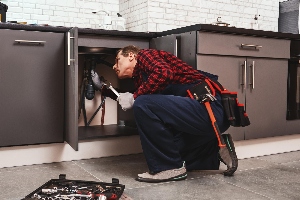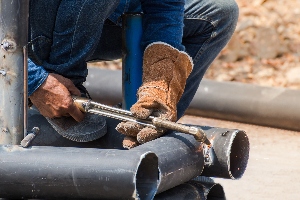Regularly inspecting and maintaining your water heater is essential for ensuring its safe operation. Neglecting these tasks can lead to dangerous situations such as gas leaks, explosions, and fires. Simple measures like checking for leaks, ensuring proper ventilation, and flushing the tank to remove sediment buildup can make a significant difference in preventing accidents.
For homeowners in Greenville and Spartanburg, South Carolina, our team at One Call Plumbing offers comprehensive water heater maintenance and repair services. Our licensed and insured professionals are dedicated to keeping your water heater in optimal condition, ensuring your family's safety and your home's integrity. Learn more here.
Understanding Water Heater Safety
A water heater can be a convenient appliance, but it also poses potential safety risks if not properly maintained. Key elements of water heater safety include proper ventilation, temperature regulation, and specific precautions for gas water heaters. Ensuring these safety measures can prevent hazardous situations like gas leaks and scalding injuries.
The Importance of Ventilation
Proper ventilation is critical for both gas and electric water heaters. For gas water heaters, ventilation prevents the buildup of dangerous gases such as carbon monoxide. Inadequate venting can lead to serious health risks or even death.
Electric water heaters also need ventilation to operate efficiently and maintain indoor air quality. Install a water heater in a well-ventilated space to ensure safe operation. If you notice symptoms of poor ventilation like headaches or dizziness, seek professional help immediately.
Temperature Regulation
Regulating water heater temperature is crucial for both efficiency and safety. Setting the thermostat too high can increase the risk of burns, while a setting that's too low can lead to bacterial growth. The recommended temperature is typically around 120°F (49°C).
Use a reliable thermostat to maintain precise temperature control. Regularly check the temperature and adjust as needed.
Avoiding Scalding Hazards
Scalding injuries occur when the water temperature is set too high. Water at 140°F (60°C) can cause a 3rd degree burn in just five seconds. To avoid scalding risks, always keep the water heater thermostat at or below 120°F.
Install anti-scald devices such as mixing valves to further reduce the risk of hot water burns. Regularly test your water temperature and adjust settings if necessary.
Gas Water Heater Specifics
Gas water heaters require unique safety measures. Monitor the pilot light and ensure it's always on; a malfunctioning pilot light could indicate a gas leak. Be aware of gas odors, which can signal a leak, and take immediate action if detected.
Regularly inspect gas lines and connections to prevent leaks. Consider installing a carbon monoxide detector near the water heater.
Water Heater Components and Their Functions
Understanding the various components of a water heater is crucial for ensuring its safe and efficient operation. Each part plays a specific role in heating and maintaining the water supply in your home.
Anatomy of a Water Heater
A typical water heater consists of several essential components.
- Tank: This is where the water is stored and heated.
- Heating Elements: Electric water heaters use resistance coils, while gas water heaters use burners.
- Anode Rod: This sacrificial rod prevents corrosion inside the tank.
- Dip Tube: Directs cold water to the bottom of the tank for heating.
- Drain Valve: Allows you to empty the tank for maintenance.
Temperature and Pressure Relief System
The temperature and pressure relief valve is a crucial safety feature.
- Function: It releases water if either the temperature or pressure inside the tank exceeds safe levels.
- Location: Typically found on the top or side of the tank.
- Importance: Prevents the tank from exploding due to excessive pressure. Ensure this valve is regularly checked and maintained. One Call Plumbing ensures proper installation and maintenance for safety in Greenville and Spartanburg, South Carolina.
Understanding the Role of the Dip Tube
The dip tube directs incoming cold water towards the bottom of the tank.
- Function: Ensures cold water is heated efficiently by keeping it away from the hot water at the top.
- Material: Usually made of plastic or copper.
- Common Issues: Over time, it may break or dissolve, affecting the heater's performance. Regular inspections can help maintain its integrity.
Gas Control and the Pilot Light
For gas water heaters, the gas control and pilot light are essential components.
- Gas Control Valve: Regulates the flow of gas to the burner.
- Pilot Light: Ignites the gas burner to heat the water.
- Safety: Modern gas heaters may feature a thermocouple, which shuts off gas flow if the pilot light goes out, preventing gas leaks.
- Maintenance: Keep this area clean and ensure the pilot light remains lit. Our experts at One Call Plumbing can handle any gas water heater issues efficiently.
Installation and Maintenance Guidelines
Proper installation and regular maintenance are critical for the safe operation of a water heater. Paying careful attention to these aspects can prevent hazards and extend the lifespan of your equipment.
Correct Installation Procedures
Ensuring a safe installation begins with choosing the right location. The water heater should have adequate clearance and proper venting. Pressure relief valves must be correctly installed to handle excess pressure.
Earthquake straps are recommended in areas prone to seismic activity to secure the tank. Proper insulation around the tank and pipes helps in maintaining efficient operation. Adhering to the manufacturer’s guidelines for electrical and gas connections is crucial. If connecting a tankless water heater, ensure proper venting specific to its design.
Regular Maintenance Schedule
A consistent maintenance schedule is vital for the safe and efficient operation of your water heater. Include checks for leaks, corrosion, and the functionality of the pressure relief valve. Regularly inspect the drain valve for signs of wear.
An annual flushing of the tank helps remove sediment, which improves efficiency and longevity. Tankless water heater systems also require descaling to prevent mineral build-up. Always refer to the manufacturer’s manual, and for expert assistance, consider calling in the professionals.
Dealing with Sediment Build-up
Sediment build-up is a common issue that can impact your water heater's performance. Minerals from hard water settle at the bottom of the tank, causing inefficiency and increasing the risk of damage. To manage this, consistently flush the tank to remove sediment.
Utilize the drain valve for this process. For tankless water heaters, routine descaling is necessary. Installing a water softener can also mitigate sediment formation. Regular maintenance ensures that sediment build-up is kept in check, extending your system's life.
Importance of Professional Home Inspection
Engaging in regular home inspections by professionals is crucial for identifying potential issues before they become major problems. Inspections should include checks on the pressure relief valve, venting, and overall system integrity. Detecting minor issues early can prevent costly repairs and enhance safety.
Safety Mechanisms and Precautions
Ensuring the safe operation of your water heater requires a comprehensive approach. Key aspects include proper ventilation, secure installation, prevention of fire hazards, and minimizing health risks from bacteria.
Ventilation and Draft Diverters
Proper ventilation is crucial to prevent the buildup of dangerous gases like carbon monoxide. Draft diverters help ensure that exhaust gases from the water heater are safely vented outside your home. It is essential to regularly check the ventilation system, including the flue and chimney, to ensure there are no obstructions.
Installing a draft diverter helps in regulating the airflow, preventing backdrafts that can draw exhaust gases back into your living spaces.
Earthquake Straps and Insulation
Securing your water heater with earthquake straps is vital, especially if you live in an area prone to seismic activity. Earthquake straps prevent the water heater from tipping over during an earthquake, which can lead to gas leaks or water damage.
Insulating your water heater and pipes can improve energy efficiency and reduce the risk of freezing during winter. Proper insulation also helps maintain the desired water temperature.
Flammable Vapor Ignition Resistance Systems
Flammable Vapor Ignition Resistance (FVIR) systems are designed to prevent the ignition of flammable vapors outside the water heater. Modern water heaters come equipped with FVIR technology, which includes sealed combustion chambers and flame arrestors to contain any ignited vapors.
Regular maintenance and inspections are necessary to ensure that the FVIR system functions correctly.
Controlling Legionella Bacteria Risk
Legionella bacteria can thrive in water heaters, posing serious health risks such as Legionnaires' disease. To control the risk, it is important to maintain the water heater temperature above 140°F (60°C) to kill the bacteria, while using a mixing valve to prevent scalding when water is delivered at lower temperatures.
Regularly flushing the tank to remove sediment buildup and installing an expansion tank can also help in controlling bacteria growth.
Responding to Water Heater Emergencies
When facing water heater emergencies, quick action is crucial to prevent property damage or injury. Understanding the right steps for handling gas leaks, mitigating water damage, preventing overheating, and ensuring safety in case of hot water burns can make all the difference.
Handling Gas Leaks and Gas Odor
If you detect a gas leak or smell gas odor, act immediately. First, shut off the gas supply valve to the water heater. Avoid using electrical switches or open flames to prevent igniting the gas. Ventilate the area by opening windows and doors.
Preventing and Mitigating Water Damage
Water damage from a leaking water heater can be severe. First, power off the water heater by shutting off the circuit breaker for electric units or the gas valve for gas models. Then, close the water supply valve to stop further leakage.
Precautions Against Overheating
Overheating water heaters can lead to dangerous situations. Ensure that the temperature control is set to a safe level, typically around 120°F (49°C). If the water feels excessively hot, there might be a malfunction with the safety valve or thermostat. In case of overheating, shut off the water heater and contact professionals immediately.
Safety Protocols for Hot Water Burns
Hot water burns are a significant risk, especially in households with children or elderly individuals. To prevent scalding risk, install a temperature control device that limits the maximum temperature. Keep the water heater set below 120°F (49°C).
In the event of a hot water burn, cool the affected area with lukewarm water for 10-20 minutes. Never use ice or extremely cold water. Seek medical attention if the burn is severe.
Understanding Water Heater Regulations and Bulletins
Proper maintenance and compliance with safety standards are essential for the safe operation of water heaters. This section will provide an overview of important governmental safety bulletins and the need for adherence to codes and regulations.
Governmental Safety Bulletins
Governmental safety bulletins are crucial in keeping you informed about current standards and potential hazards linked to water heaters. These bulletins often come from agencies like the Consumer Product Safety Commission (CPSC) and the Environmental Protection Agency (EPA).
They cover a broad range of topics, including installation guidelines, usage tips, and recall notices. For instance, bulletins can highlight the importance of proper ventilation to avoid carbon monoxide buildup or the necessity of installing temperature pressure relief valves to prevent explosions. Staying updated with these bulletins ensures that any new safety information is promptly applied to your household appliances.
Codes and Regulations Compliance
Compliance with building codes and regulations is not just a legal requirement but a critical step in ensuring the safety and efficiency of water heaters. Key regulations include proper venting, correct temperature settings, and the installation of necessary safety devices.
Building codes from organizations such as the International Code Council (ICC) and American Society of Mechanical Engineers (ASME) provide detailed standards. These include specifications on clearance space around water heaters, pressure valve settings, and proper electrical grounding.
Ensuring compliance with these regulations requires not only knowledge of the codes but also their practical application.
Contact us to see what we can do for you.












